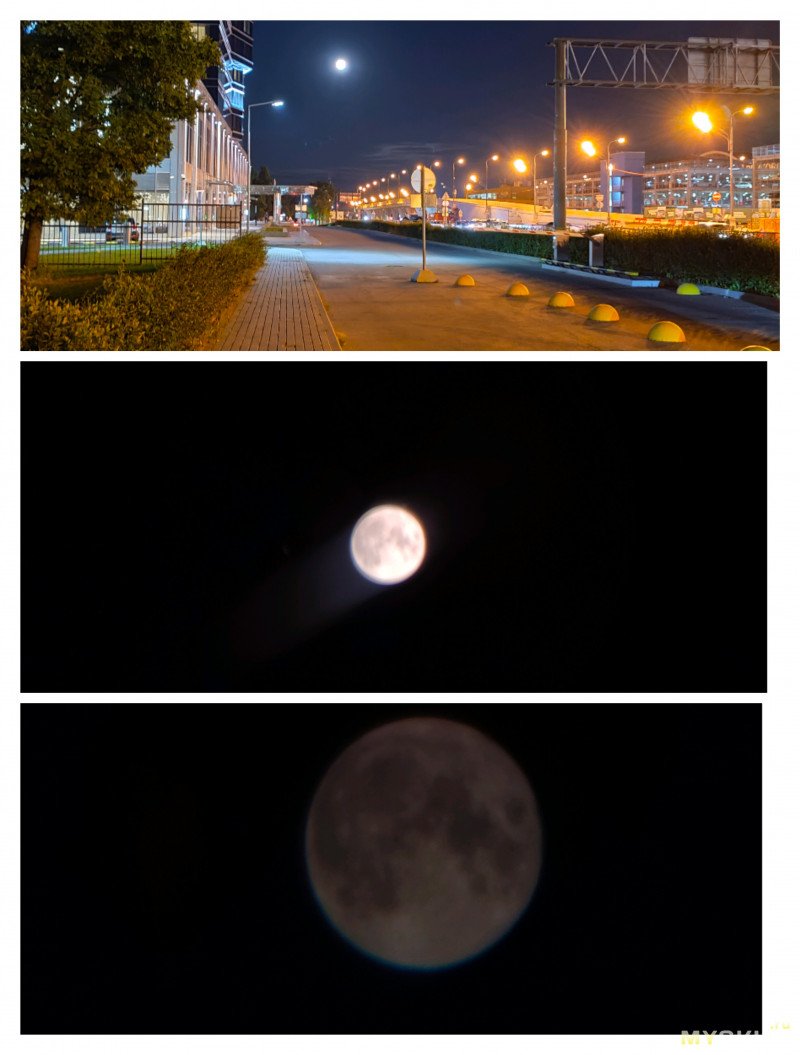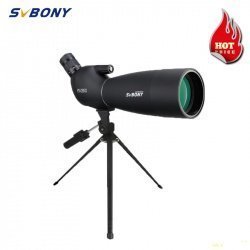3. Optical magnification: 25-75 times 15. Review published in accordance with clause 18 of the Rules Exit pupil diameter: 0.9-2.8mm
There is no limit to perfection, as it turns out, and there is no limit to the increase of objects through "premium » version of the SVBONY SV28 spotting scope. 9.
For comparison, magnification through a small monocular is presented (the price of which without discounts is 900 rubles ($12)): The eyepiece is located at an angle of 45⁰С to the optical axis
Second example of magnification of a distant object at night: 4. 8. 10. The first one has a review by user bdos. Specifications of the telescope: The positive characteristics of the monocular include the fact that the type of prism BaK 4 is used, as it is of higher quality than BaK 7, in particular (on which the “green” standard modification of the SV28 model is based). 12. 16. The telescope is better than its younger model with a 15mm lens. The following is an overview of the SVBONY SV28 spotting scope in black and a comparison of the resulting images with the simplest small monocular. In fact, distortion and aberration are at a minimum through the SVBONY monocular.
As for observing the Moon specifically, SV28 is not https://jiji.ng/lagos-mainland/22-air-conditioner/mobile very suitable. As the Moon will be available in the night sky during the "golden" hour of observation, I will supplement the review.
Inside there is a tripod in a bag, a case with a telescope, instructions and a napkin: It is proposed to discuss and present a second monocular for observing birds, distant objects, nature further.
The fourth example of magnification of objects located far from the observer through SVBONY SV28: When fully unfolded, it raises the telescope by 26 cm. The first one, taking into account the promotional code SV28BLACK888 for 298 rubles. ($4) costs 4480 rubles. ($60), the second by the promo code SVBONY88RU for 373 rubles. ($5) – 3541 rubles ($47). There are two versions of the SV28 in the store, which can be simply divided into two colors: green and black. The following photograph of the Moon through visual labor is the highest quality that has been captured recently: Objects across the visible area correspond to the magnification scale.
Example of magnification of a not very distant object at night:
The telescope comes in a box with the magnification parameter and lens diameter — 25-75×70:
Example of magnification to a distance that feels more than 10 km:
The height of the tripod is 32 cm, which is not much. if the focus is made on the object, then everything is seen well and without distortion. Prism: Porro BaK 4 Weight: 1 kg (with tripod), 0.7 kg (monocular) Photographs do not represent all the clarity that can be obtained when viewed through an eyepiece. Phone holder sold separately. Tripod screw thread: UMC 1/4-20 Eye relief: 14-16 mm
The picture comes out with a lot of noise, so zooming in on the phone doesn’t improve the quality. The second option for convenient use is to purchase a tripod of greater height. Housing: rubberized and waterproof (IP65) Now the SVBONY spotting scope is ready for "field" testing:
I did not indicate the diameter of the lens itself, but from the end to the beginning of the body, since it definitely didn’t work out
measure, but I don’t want to confuse with incorrect numbers. 7. I hid the exception to the rule under the spoiler, but there is an exception that does not contain many details and is just lucky. SVBONY SV28: Minimum focus: 8m The zoom range, which has been shown in practice, corresponds to about 10 km. The third example of comparing the SVBONY product with the second one, but already in the morning conditions of visibility. In both cases, a seller’s coupon for 75 rubles is applied. ($1) and coins. 13.
Small monocular: The last one mentioned uses BaK 7 and a 15 mm eyepiece. The best image quality is promoted by the type of prisms used (BaK 4) and the adjustable zoom. The distortions that you can see in the above photos did not come from quite the right exposure and sun glare. This height implies that the monocular will be used on the ground or it will stand on a raised platform. The product was provided for writing a review by the store. The difference between the black "premium", as I called the SV28 model in the review, and the green "standard" version is in the type of prism used (BaK 4) and the diameter of the eyepiece (20 mm). The center is focused very clearly. Monocular height: 14 cm (without tripod), 46 cm (with tripod) If a lot of objects fall into the lens at a distant distance, then distortions are inevitable along the edges of visible objects, on which focusing is not performed
An example of magnification in cloudy and rainy weather: Lens diameter: 70mm Multicoated lenses For simplicity, I will continue to appeal to the named number, but we must keep in mind that it is from the ceiling: All optics are multi-coated, which allows you to better observe objects and objects in low light. 5. Distortion is practically not noticeable. 14.
https://tonaton.ng/s_287-sauces from a tripod (although the second monocular also has an entrance under 1/4, but it was poorly fixed in it), and in
the fact that the quality of the lenses and the focus do not go into any gate at all. 6. The sky has “appeared”, so below are photos of the Moon: Eyepiece diameter: 21mm There is also a photograph of the maximum zoom (x75) for a long distance (as it seems, more than 10 km), as well as an estimate of the declared optical zoom of 25-70 times – the average deviation is small. Chromatic distortion and aberrations, typical for products with a moving zoom, are practically not observed in the SV28 model, if only along the SC edges of the visible zone and if the focus is built on one of the objects in the frame, provided that the objects are separated by perspectives.  Angular field of view (real): 0.9-1⁰
Angular field of view (real): 0.9-1⁰
The second product has a magnification of x300, but, of course, it is not there.
The size of the monocular is 38x(14/5) cm (length and height in the finder and lens area, respectively), the diameter of the viewfinder is 21 mm, the lens is 82* mm: 1. However, this is an exception to the rule: it is undoubtedly more convenient with a tripod.
I also took pictures with my hands, but the quality turned out better than the previous https://tonaton.ng/s_287-sauces version. 2. Similar photos are shown below, but zoomed in on the phone: 11. It remains to wait for a clear sky in the evening and a full moon in order to test the maximum magnification through a 21 mm eyepiece and an optical magnification of x75 times.
SVBONY SV28 Spotting Scope: "premium" black edition
 Sun glare reduction cap Field of view at a distance of 1 km: 16-33 m
Sun glare reduction cap Field of view at a distance of 1 km: 16-33 m
